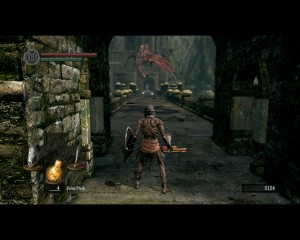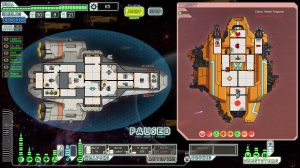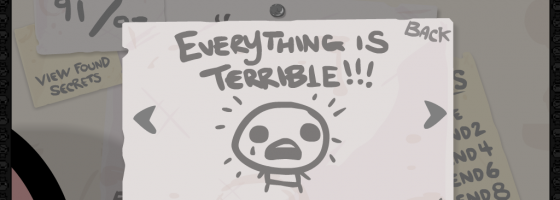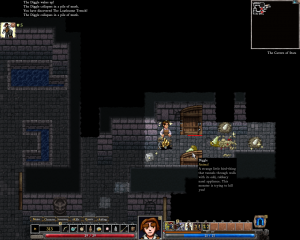A few weeks ago I wrote about the underrated title — Breath of Fire: Dragon Quarter which added both tactical gameplay and roguelike elements to the RPG series. In that post I said that the game was ahead of its time as one of the first mainstream games to introduce roguelikes to the general consumer.
Since then, we have seen a number of games featuring roguelike mechanics released and what was once a genre made only for the hardcore, has soften up to some extent.
Tough Love:
To examine how the roguelike genre has changed we first need to define the major elements of it.
Roguelikes originally started out as a sub genre of RPGs and similar to real time and turned based strategy games, the differences quickly differentiated and gave us two different genres.
At its core, there are three elements inherent of the rogue-like genre: randomization, variety and weighted actions/punishment. All three combined make for titles with high replayability. Now, before we start breaking down each element, fans of the genre may notice something missing — extreme difficulty.
While roguelikes are known for being difficult games, the designs seen in the genre are not inherently difficult and instead are more subjective base. Learning the rules and systems will allow you to make headway in a roguelike and you will eventually be able to subvert the systems to your advantage.
Let’s start breaking the genre down with examining randomization. Having the game generate an entirely new gamespace with each new game is a major component of both difficulty and replayability. With difficulty, because you never know what you are going to find, the game can be harder or easier based on how the world is generated.
Games with roguelike elements may be built around different degrees of randomization. At the core of the system there are usually certain elements that are set such as the gradual increase of equipment quality and stronger enemies.

Both Demon’s and Dark Souls gave the player a variety of options on how to build their character, with no perfect strategies.
Variety is about giving the player multiple ways of progression and equipment.
The point is to increase replay value as the player should be able to build completely different characters and strategies with each play.
If the player finds an always optimal build then the developers have failed.
Lastly, weighted actions/punishment has to do with keeping the player on their toes at all time. It is customary in most rogue-likes that you only have one life, making every choice a possibility between life and death.
Early roguelike games featured a combination of all three and were as much replayable as they were challenging. Funny enough, it would take a game with high difficulty to offer a casual roguelike experience.
The Casual Game of Demon’s Souls:
Demon’s Souls for the PS3 was one of those games that arrived quietly in the US, but a fanbase wanting a hardcore RPG and impressions from Japan turned the game into a major hit. Demon’s Souls was actually my first PS3 game I bought, 3 months before I actually bought a PS3.
Now, we could spend the entire article (and then some) breaking down every aspect of what made Demon’s Souls a great game, but we’re going to focus on the roguelike elements.
First as you may know, Demon’s souls was not a game built around randomization. Every blade of grass, door and enemy was purposely placed to challenge the player. That singular fact was what prevented Demon’s Souls from being a true roguelike.
However, not being randomized was what helped Demon’s Souls accessibility. The set design of the game meant that players would not have to worry about the game’s challenges being different on multiple plays. This made learning the game easier and gave the player the ability to train and improve themselves for harder fights.
With variety, Demon’s Souls offered players multiple weapons, spells and builds to play as. The classes only determined the base stats and starting equipment, leaving everything else up to the player. Later boss fights were designed to be harder or easier based on the player’s overall build (close range, archer, and spellcaster.)
Weighted actions are where Demon’s Souls‘ design gets interesting, as this is another area where we see the middle ground between a normal RPG and a rogue-like.
If the player died, they dropped all accumulated souls (used for both leveling up and buying items) and all defeated enemies respawned.
Die again before recovering your souls and they were gone for good.
What was different about Demon’s Souls death punishment was how on one hand it was brutal for normal fans of RPGs not used to it, but at the same time it was casual for people used to roguelikes where you only had one life. By designing the game in this method, the designers made the player’s actions heavily weighted and forced them to learn the game.
Demon’s Souls was the closest a game aimed for the mainstream audience got to roguelike design at the time. There is no evidence that Demon’s Souls was the spark that made roguelikes viable for the mainstream, but following its success we saw new games with roguelike design.
Light-Hearted Roguelikes:
Most roguelikes were developed by Indies and following Demon’s Souls‘ success, that trend would continue.
In the last few years we have seen more games from the indie market developed with roguelike mechanics and different degrees of difficulty.
FTL was not only a great Roguelike but it was also one of the first major kickstarter success stories: Earning over 2000 times what they were asking for. FTL’s gameplay was not so much a turn-based RPG, but was more about spaceship combat. Featuring a randomized gamespace and only one life per game gave it a lot of challenge.

FTL was one of many games that featured the essence of a roguelike without the usual designs of turn based RPG gameplay.
Dungeons of Dredmor was the first game from indie studio: Gaslamp Games and did an even better job of creating an accessible roguelike than Demon’s Souls.
The game featured the classic gameplay of turned based RPG play but with a modern touch to graphics and UI. Players could define their character from a number of serious and not so serious class traits and explore a randomized world.
Incidentally, for adhering so much to classic rogue-like design and mechanics, the developers did something very different: they offered a casual mode. Playing Dredmor on casual mode, death would not end your game but instead knocked your character out and you could start the floor again.
Action games: whose focus on player skill was a genre that did not focus on roguelike design. However, we’re starting to see more action games built with roguelike mechanics.
The recent release of Rogue Legacy combined rogue-like exploration and difficulty with side scrolling twitch based combat. Super House of Dead Ninjas which I looked at a few months ago challenged action gamers with descending a randomly generated tower.
One of my favorite games: The Binding of Isaac was a combination of basic 2d gameplay with a randomized level design and progression system. The game was designed around the fact that it was meant to be replayed and used the progression system to add new items, enemies, and levels to the randomization the more achievements the player unlocked.
As we’ve seen, roguelike design is no longer limited to the genre and has become another way of adding interesting mechanics. Today, it’s not about punishing the player to the point of making them quit, but designing a game varied and interesting enough to keep them coming back.



